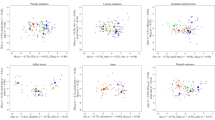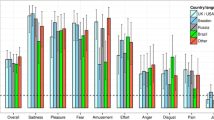Abstract
Previous studies have examined verbal rather than vocal aspects of irony. The present study considers how vocal features may cue listeners to one form of irony--sarcasm. Speakers were recorded reading sentences in three conditions (nonsarcasm, spontaneous sarcasm, posed sarcasm) with the resulting utterances filtered to remove verbal content. Listeners (n = 127) then rated these filtered utterances on amount of sarcasm. Results indicated that listeners were able to discriminate posed sarcasm from nonsarcasm but not spontaneous sarcasm from nonsarcasm. An analysis of the vocal features of the utterances as determined by perceptual coding indicated that a slower tempo, greater intensity, and a lower pitch level were significant indicators of sarcasm.
Similar content being viewed by others
REFERENCES
Ackerman, B. P. (1983). Form and function in children's understanding of ironic utterances. Journal of Experimental Child Psychology, 35, 487–508.
Argyle, M., Alkema, F., & Gilmour, R. (1971). The communication of friendly and hostile attitudes by verbal and nonverbal signals. European Journal of Social Psychology, 1, 385–402.
American heritage dictionary (2nd edn.). (1991). Boston, Massachusetts: Houghton Mifflin.
Brown, P., & Levinson, S. C. (1987). Politeness: Some universals in language usage. Cambridge, England: Cambridge University Press.
Buck, R. (1984). The communication of emotion. New York: Guilford Press.
Bugental, D. E. (1974). Interpretation of naturally occurring discrepancies between words and intonation: Modes of inconsistency resolution. Journal of Personality and Social Psychology, 30, 125–133.
Clark, H. H., & Gerrig, R. J. (1984). On the pretense theory of irony. Journal of Experimental Psychology, 113, 121–126.
Costanzo, F. S., Markel, N. N., & Costanzo, R. R. (1969). Voice quality profile and perceived emotion. Journal of Counseling Psychology, 16, 267–270.
Frick, R. W. (1985). Communicating emotion: The role of prosodic features. Psychological Bulletin, 97, 412–429.
Grice, H. P. (1975). Logic and conversation. In P. Cole & J. L. Morgan (Eds.), Syntax and semantics: Vol. 3. Speech acts (pp. 41–58). New York: Academic Press.
Jorgensen, J., Miller, G. A., & Sperber, D. (1984). Test of the mention theory of irony. Journal of Experimental Psychology, 113, 112–120.
Krauss, R. M., Apple, W., Morency, N., Wenzel, C., & Winton, W. (1981). Verbal, vocal, and visible factors in judgments of another's affect. Journal of Personality and Social Psychology, 40, 312–319.
Kreuz, R. J., & Glucksberg, S. (1989). How to be sarcastic: The echoic reminder theory of verbal irony. Journal of Experimental Psychology, 118, 374–386.
Levinson, S. C. (1983). Pragmatics. Cambridge: Cambridge University Press.
McDevitt, T. M., & Carroll, M. (1988). Are you trying to trick me? Some social influences on children's responses to problematic messages. Merrill-Palmer Quarterly, 34, a 131–145.
Mehrabian, A., & Wiener, M. (1967). Decoding of inconsistent communications. Journal of Personality and Social Psychology, 6, 108–114.
Ohala, J. J. (1983). Cross-language use of pitch: An ethological view. Phonetica, 40, 1–18.
Preminger, A. (1974). (Ed.) Princeton encyclopedia of poetry and poetics. London: Macmillan.
Rosenthal, R. (1985). Conducting judgment studies. In K. R. Scherer and P. Ekman (Bds.), Handbook of methods in nonverbal behavior research (pp. 287–361). Cambridge: Cambridge University Press.
Scherer, K. R. (1974). Acoustic concomitants of emotional dimensions: Judging affect from synthesized tone sequences. In S. Weitz (Ed.), Non-verbal communication (pp. 105–111). New York: Oxford University Press.
Scherer, K. R. (1979). Nonlinguistic vocal indicators of emotion and psychopathology. In C. E. Izard (Ed.), Emotions in personality and psychopathology (pp. 495–529). New York: Plenum.
Scherer, K. R., & Oshinsky, J. S. (1977). Cue utilization in emotion attribution from auditory stimuli. Motivation and Emotion, 1, 331–346.
Sigelman, C. K., & Davis, P. J. (1978). Making good impressions in job interviews: Verbal and nonverbal predictors. Education and Training of the Mentally Retarded, 13, 71–77.
Sperber, D. (1984). Verbal irony: Pretense or echoic mention? Journal of Experimental Psychology, 113, 130–136.
Sperber, D., & Wilson, D. (1986). Relevance: Communication and cognition. Cambridge, Massachusetts: Harvard University Press.
Winner, E., Levy, J., Kaplan, J., & Rosenblatt, E. (1988). Children's understanding of nonliteral language. Journal of Aesthetic Education, 22, 51–63.
Zuckerman, M., DeFrank, R. S., Hall, J. A., Larrance, D. T., & Rosenthal, R. (1979). Facial and vocal cues of deception and honesty. Journal of Experimental Social Psychology, 15, 378–396.
Zuckerman, M., Hall, J. A., DeFrank, R. S., & Rosenthal, R. (1976). Encoding and decoding of spontaneous and posed facial expressions. Journal of Personality and Social Psychology, 34, 966–977.
Author information
Authors and Affiliations
Rights and permissions
About this article
Cite this article
Rockwell, P. Lower, Slower, Louder: Vocal Cues of Sarcasm. J Psycholinguist Res 29, 483–495 (2000). https://doi.org/10.1023/A:1005120109296
Issue Date:
DOI: https://doi.org/10.1023/A:1005120109296




